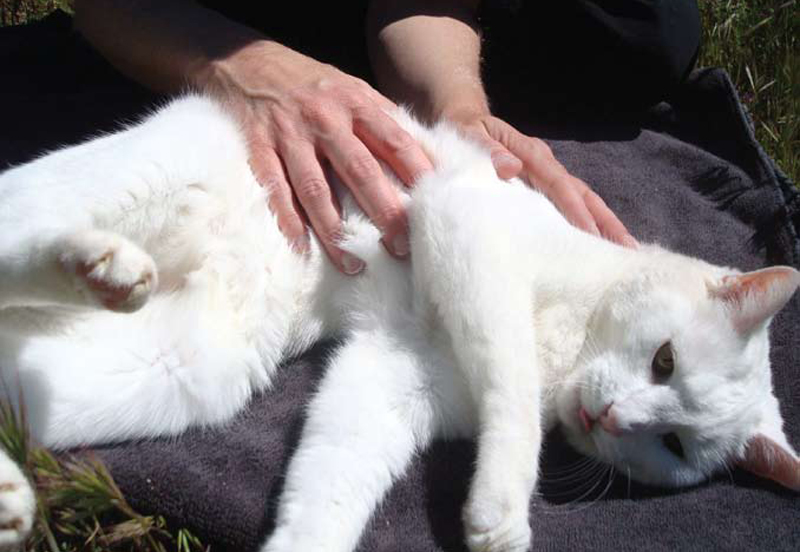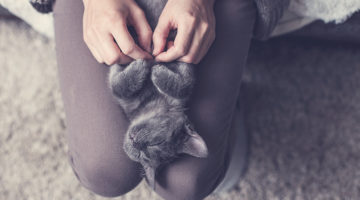Massage isn’t just for people and dogs. Cats also benefit – and they love the attention!
I often get strange looks from people when I reveal that I’m an animal massage therapist. When I add that my clientele includes cats, they usually express disbelief. But as cat lovers know, most kitties relish attention and adoration – and they also love massage!
Cats are natural healers. The frequency of a cat’s purr has been scientifically proven to have therapeutic effects – it can relax muscles, strengthen bone and has a positive effect on our moods. And we’ve all experienced the bliss of loving kitty paws gently kneading us. Shouldn’t we return the favor?
Massaging your cat provides him with various health benefits; it also positively affects your own immune system while lowering your blood pressure and deepening your bond with your precious companion. Regular massage also teaches you what your cat feels like normally, so you’ll notice any lumps, bumps or other health changes early on.
“Massage aids the activity of pain-killing biochemicals such as endorphins, and regulates immune system cells at specific sites in the body,” explains veterinarian Dr. Annie Harvilicz of Animal Wellness Centers in California. “Many of our feline patients tend to be anxious and untrusting at first. We often use massage therapy to ease cats into acupuncture treatment.” Dr. Annie adds that massage “is great for treating arthritis, inflammatory bowel disease, diabetes, liver disease, kidney disease and many others. We are strong believers in therapeutic massage, given its sound basis in science and our first hand, real life experience with our own feline friends.”
Massage enhances toxin elimination as well as the circulation of blood, lymph, nutrients and oxygen to the body’s tissues, encouraging healing and preventing injury. Massage also stimulates the parasympathetic nervous system, allowing relaxation. It has been shown to safely increase brain levels of the “feel good” transmitters dopamine and serotonin, while reducing the stress hormones, cortisol and adrenaline. Massage is great for
calming scaredy cats!
Massage should not be used if a cat has a fever, or is in shock or vomiting. Sores, rashes, skin infections, tumors and lumps should be avoided during a massage session. And keep in mind that massage never takes the place of proper veterinary care.
Try this at home
- First, offer your cat fresh water. Drinking before and after the session helps flush out toxins.
- Wash your hands, dim the lights, play calming music and get yourself and your cat comfortable. Close your eyes, take a deep breath and exhale slowly, letting go of all your worries. Enjoy this quiet relaxation time. Keep your breathing slow and relaxed.
- Begin with effleurage from head to tail. Effleurage involves slow, long, gliding, continuous, soothing strokes with a flat, relaxed palm, alternating hands and slowly increasing pressure. Effleurage warms and flushes the tissues, stretches muscle fibers and relaxes them for deeper work, helps identify spasms, swelling, and knots, and clears areas of lactic acid.
- Try to keep both hands on your cat to maintain a constant connection. Always operate on the cat’s feedback and adjust your intuitive touch accordingly. Massage both sides of the body for balance.
- Ears contain many nerve endings and acupressure points around the base to the tips. Massage them around the base and use thumb strokes out to the tips for a calming effect.
- Once the tissues are warmed up, use friction massage to break up adhesions and scar tissue (which limit range of motion). Use your fingers or thumbs across muscle fibers, following down the fur line on both sides of the spine, and on other muscled areas.
- Deeper massage, called petrissage, begins with gentle kneading and loose skin rolling, then moves to wringing, which involves picking up and squeezing relaxed, warmed muscles. Start superficially at the loose skin of the neck and back, and slowly work deeper with a gentle, intuitive touch. Intersperse plenty of effleurage strokes to drain toxins.
- Stretching realigns muscle fibers, speeds up the muscle recovery process necessary after exercise (massage is a passive form of exercise), and opens up joint spaces to allow more fluid to be produced. Slow, fluid, gentle stretches are done only after the muscles are warmed up, supporting both sides of the joint, and never with force or past the point of resistance. Tenderly flex and extend the cat’s toes, wrists, elbows, ankles and knees. With your cat on his side, slowly bring one front leg forward for a shoulder stretch and back to its resting place. Do this four times, holding the position for eight seconds each time. Then slowly bring the leg back for a biceps/deltoid stretch – again, four times at eight seconds each. Gently bring the back leg forward for a buttocks stretch, then stretch the knee and pelvis by gently bringing the leg back. Gently shake out the limbs with vibrating hands, and do light percussion with relaxed hands and wrists – this is called tapotement.
- Close the session by slowing your effleurage strokes and decreasing pressure. Use passive touch by briefly placing your hands all over the cat’s body, without movement or pressure but with a loving intent.
- After the massage, your cat should drink and may need to urinate. Next, enjoy a catnap together, and you’ve given yourselves a perfect afternoon! During the first few times you massage your cat, he may be unsure and even give you love bites. Try short sessions on a regular basis, and he’ll soon be plopping in front of you expecting a rubdown!








No Comment